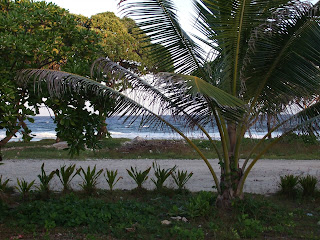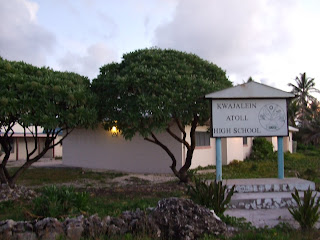Every day I get scraps of paper explaining my students’ absences. From the signatures I learn a little bit about which students are living with their parents, and which students have come from outer islands to live with a relative on Ebeye so they can attend high school.
Some excuse notes are standard high school rubbish. Yesterday I intercepted a note being passed in class. Instead of the usual high school gossip, it was an excuse note she was forging for her friend. After class the note writer asked for the note back. “It’s my friend’s excuse note. She needs it.” I asked, “Who wrote it?” She giggled and said “Me.” That’s one thing I’ve noticed about Marshallese students so far – they do all kinds of mischievous stuff, but if you ask them if they did it, they’ll say “yes.” I haven’t had any students lie to me yet that I know of. (No, I didn’t give the note back to her.)
Here’s a composite from actual phrases from excuse notes from my students: “He was absent yesterday because he was haveing a stomach age. I thing he is okay now. Please accuse him.”
Here’s another: “Sorry Miss Marci I can’t be in your class today because I am having a girl sickness.” Yes, up to 50% of my class is absent for up to 5-7 days every month. I think, but do not say, “Buck up and take it like a woman!”
But some excuse notes tell even more about the tough lives some of these kids lead.
“Please excuse her absence yesterday. She had to take her daughter to the hospital.” Let me get this straight. My 10th grader is old enough to have a daughter, but not old enough to cover her own absence in school. She needs her mother to write her excuse note, to explain that she needs to take her baby to the hospital. Through it all, she’s staying in school.
Here’s another one: “She had to get her tooth pulled. It’s been hurting for a long time, but we didn’t have the money. Now we have the money, so she got the tooth pulled yesterday.” Many older adult Marshallese I’ve met are missing teeth. I’m no dentist, but even among my 10th and 11th graders I can see cavities, even on their front teeth. Lack of dental care and a terrible diet with lots of sugar all day long contributes to the problem. A favorite snack is Kool-Aid powder, served on a licked finger right out of the package. One day one of my students mixed the Kool-Aid powder with a ramen noodle spice packet and offered me a taste. “Thanks, but no thanks.”
One more excuse note: “Please excuse my son’s absence yesterday. He had to go to his cousin’s funeral.” I recorded the excused absence in my book and handed back the note to the student with a gentle “I’m sorry to hear the news.” He found me after school to talk to me. He explained that his cousin had committed suicide, using gestures to indicate disemboweling himself. The cousin was in his late twenties, leaving behind five children, the youngest of whom would have been a year old next month. “We all tried to talk him out of it, his friends and me, but he was stubborn and wouldn’t listen.” Suicide is the leading cause of death among Marshallese young adult men, in a remote land with few jobs or educational opportunities, and no way to ever afford getting off the island. The future often seems a bleak dead-end as a subsistence fisherman. I keenly felt my student’s burden, not only grieving for his cousin, but perhaps wondering whether he might have thought of the right thing to say so that his cousin would be alive today.
These are not your ordinary high school excuse notes.














